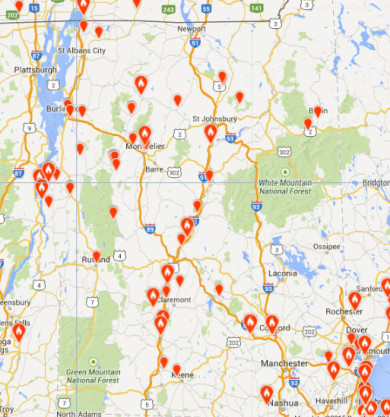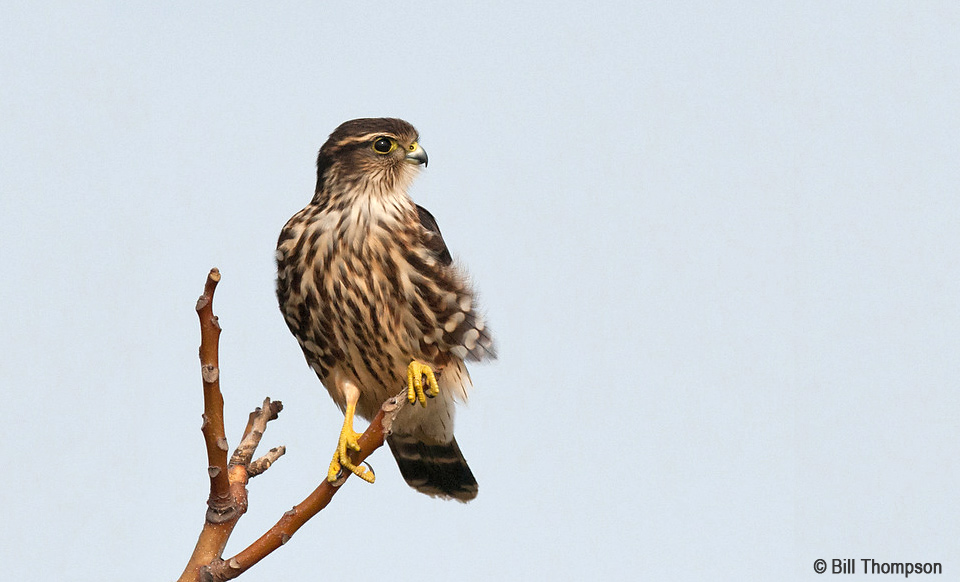LIKE A CROSS BETWEEN A CRUISE MISSLE AND A T-REX, they are flying and killing machines. And for more than a week now, particularly here in my home town of Montpelier, they’ve been flying and killing over Vermont. Most Vermonters have no clue they’re here.
During this week alone, I’ve had five encounters with Merlins: four in Montpelier (including a pair soaring over downtown yesterday) and one in Burlington. At this moment, you are probably not too far from a Merlin. They’re migrating through much of the continent on their way to breeding territory across boreal Canada (and, more recently, here in Vermont).
Among falcons, the Peregrine gets the glory. But pound for pound, the smaller Merlin moves with the force and determination I find few other animals. Peregrines, from their high, exposed perches, tend to swoop on and pursue their prey, which includes small mammals and birds as large as waterfowl. Merlins do some of that, but with amazing bursts of energy and agility Merlins simply chase and overtake small songbirds in flight. A Merlin can make a Peregrine by comparison look lethargic. Merlins can even pluck dragonflies from flight.
About 20 years ago, I got a call from someone advising me that a pair of Merlins had commandeered an old crows nest and were raising young in the Morrisville Cemetery. Skeptical about the report (more on that in a bit), I drove to the spot, parked my truck and soon noticed wispy golden feathers floating around me on the summer breeze. I looked up to find a Merlin, near a nest, picking apart an American Goldfinch.
During my birding trips to Monhegan Island, Maine, each fall, we have dozens of encounters with Merlins jetting around the island, often in pursuit of migrating Northern Flickers. When chased by a Merlin out there, flickers utter a plaintive call that I rarely hear anywhere else. So common are these pursuits, and the flicker’s cries of help, that we simply call the sound “FID” – flicker in distress.
Unlike many birds whose breeding ranges have shifted north on our warming planet (sometimes correlation, sometimes causation), Merlins have expanded their range southward. Historically breeding across Canada and only portions of the American mountain West, Merlins now nest here in Vermont and other scattered points in the northern Northeast, from remote forests to urban parks. Twenty years ago, Merlins were rare in the US.
 Here in Montpelier during the past few days, I have encountered Merlins in the following locations:
Here in Montpelier during the past few days, I have encountered Merlins in the following locations:
- The white pines in the parking lot of the Montpelier Senior Activity Center (whose big rummage sale is today and Saturday)
- The Cummings Street Bridge over the North Branch of the Winooski River
- High over Hubbard Park near Coarse Street (could be the same individual I saw on Cummings)
- A pair over Kellogg-Hubbard Library
For every one else, here’s a Vermont eBird map of Merlin sightings this month.
The best way to find Merlins is to hear their laughing chatter. (The Montpelier birds have been vocalizing a lot. I wouldn’t have noticed the Burlington Merlin, flying over the University of Vermont campus on Tuesday, had it not been calling). When you hear the sound, look up to find your rocket on angled wings. And if you see evidence of any Merlins nesting here in Montpelier, please send me an email. Thanks.


Today, September 20, at about 3500 ft up Mt Ellen we think we saw an immature merlin: brown with banded tail.
Does that sound reasonable?
I have kind of a sad story if you’re a merlin fan but interesting. Several years ago around late July in 2014 perhaps, my colleague and I were taking plankton samples for an aquatic invasive species survey on Teal Lake in Sawyer county in Wisconsin.
My colleague was condensing a sample that we just collected when I noticed a merlin vocalizing distress and flying tight circles over mature white pines on the nearby shoreline. Directly below there were three other birds that I thought were merlins with my unaided eyes. One of them was on the back of another appearing like it was breeding and the third was onlooking on a nearby perch.
I questioned my thought that merlins would be breeding in late July so I got out a pair of binoculars to observe more closely. Upon, closer scrutiny, I could see that the three perched birds were two sharpshins and one merlin. The one sharpshin (an adult) was on the back of a merlin (a fledgeling perhaps) and killing it. The onlooker was another sharpshin (perhaps a fledgeling also). With our sample finished, we moved on not wishing to see the grisly scene to its end.
In speculation, could the fledgeling merlin perhaps mistake the adult sharpshin as the adult merlin bringing it food, then getting preyed upon itself? I would guess that it could probably recognize it’s parent but maybe delay it’s reaction enough to not get away.
Just thought I’d share this.
There was one hanging out behind our camp on a bay of Norton Pond this afternoon!
My husband and I just watched a Merlin pair for a good while today in Underhill Center. Fantastic, impressive and agile creatures! Wow. Fierce. What a treat to witness them.